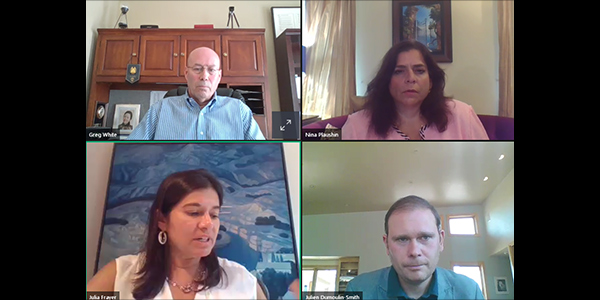The impact of the coronavirus pandemic on electric demand could lead some state regulators to reconsider their transmission rate structures, former FERC and North Dakota Public Service Commissioner Tony Clark told WIRES’ virtual Summer Meeting on Thursday.
Clark, a former president of the National Association of Regulatory Utility Commissioners, said state regulators took a “do no harm” approach at the beginning of the pandemic by suspending service cutoffs for nonpayment.
Now, utilities and regulators are trying to determine how to deal with the bad debts that have mounted as many unemployed become unable to pay their electric bills. Utilities will likely be permitted to create regulatory assets for those debts and then engage with regulators in proceedings about recovering the debts, Clark said.
“Either government steps in and picks up the tab for all this societal debt that the utilities are holding, or … you allow the utilities to recover that through rates over some period of time,” Clark said. “But there really aren’t a lot of other options besides some variation of those two concepts.”
The long-term impact, he suggested, could be a change in the “political tradeoff” that has seen many jurisdictions collect much of their utilities’ fixed costs through volumetric charges.
“When you have something like the pandemic hit and volumetric usage drops off dramatically, at least for some classes of customers, that means you’re going to have a utility cost-recovery system that doesn’t work anymore,” Clark said. “So, this is what regulators will be dealing with: trying to figure out what the new normal is … in terms of volume. I think it leads regulators to a place where they begin to look more seriously at trying to recover fixed costs through fixed charges and variable costs from variable charges, which is probably where we should have been all along.”
Clark said commercial and industrial customers’ subsidization of residential ratepayer use also could be reconsidered.
Zach Smith, vice president of system and resource planning for NYISO, said New York power demand is about 7% lower than normal following the “astounding” 33% drop in GDP in the second quarter.
While a typical recession is often followed by two years of recovery, this downturn is the result of the “externality” of COVID-19, Smith said. “So there is a real debate about what that recovery is going to be, [and] it’s really a huge question mark as to how this energy demand is going to recover.”
Chatterjee on Order 1000 Disappointment
FERC Chair Neil Chatterjee, speaking via satellite phone from Montana, briefed the conference on the commission’s May order on return on equity and its Notice of Proposed Rulemaking on transmission incentives.
Chatterjee said he was confident Opinion 569-A on ROE “better reflects investor expectations … and is also legally durable so that it will stand up if challenged in court.” The commission said it would consider three inputs in its ROE calculations: the risk premium model, the discounted cash flow and capital asset pricing model. (See FERC Ups MISO TO ROE, Reverses Stance on Models.)
The chairman said he was eager to review comments due in mid-August on FERC staff’s June white paper on cybersecurity incentives (AD20-19). (See FERC Seeks Comments on Cyber Investment Incentives.)
Chatterjee said “one of his great disappointments and frustrations” has been the inability to address Order 1000’s failure to produce the “innovation and cost discipline” he hoped would result from opening transmission development to competition.
“We’re at a point now where I think Order 1000 clearly isn’t delivering the results that were initially envisioned,” he said. “That, unfortunately, is where the agreement ends. What to do about it is a very challenging thing.
“What I’ve just come to recognize [is that] with all of the other complex challenges that we are facing, to try and reopen Order 1000 right now would be biting off more than we could chew. So, what I’m focused on is interacting with stakeholders to see if there are targeted fixes that the commission can examine.”
Transmission Incentives NOPR
FERC’s controversial NOPR on transmission incentives, which generated much comment and criticism in its docket in July, was the subject of WIRES’ final panel, moderated by Nina Plaushin, vice president of ITC Holdings. (See Tx Incentive NOPR Leaves Many with Sticker Shock.)
NARUC Executive Director Greg White, a former Michigan regulator, said he welcomed a fresh look at the policy. “I’m not convinced that FERC’s past incentives have been very effective,” he said, noting he was speaking for himself and not on behalf of NARUC.
White was particularly critical of the adder for participation in an RTO, which FERC has proposed increasing from 50 to 100 basis points. He agreed with Commissioner Richard Glick’s observation that transmission owners are unlikely to leave RTOs and noted that some states require their utilities to participate.
Julia Frayer, managing director of London Economics International, spoke about her white paper, which WIRES submitted with its comments on the NOPR. The paper contends TOs take on risks by joining RTOs because of the grid operators’ “governance and operational nature.” The paper also made the case for a transmission technology incentive.
Julien Dumoulin-Smith, managing director at BofA Securities, gave a passionate, highly caffeinated seven-minute speech, beginning with his argument for why “people’s historical understanding of how to establish ROEs are upside-down.”
He ended by urging transmission planners to begin thinking about the role hydrogen could play under electrification that doubled renewables and the size of the grid.
“How do you see the hydrogen role evolving? Is it a midstream industry? Do you do things [with hydrogen] and then send it on electricity? It’s an open question. We’ve seen these tensions between gas — gas by wire and gas midstream itself,” he said.
Transmission planning should reflect how “you think about a distributed or centralized hydrogen economy 30 to 40 years from now,” he said. “I throw that out as my big-picture thought. Take it or leave it.”







